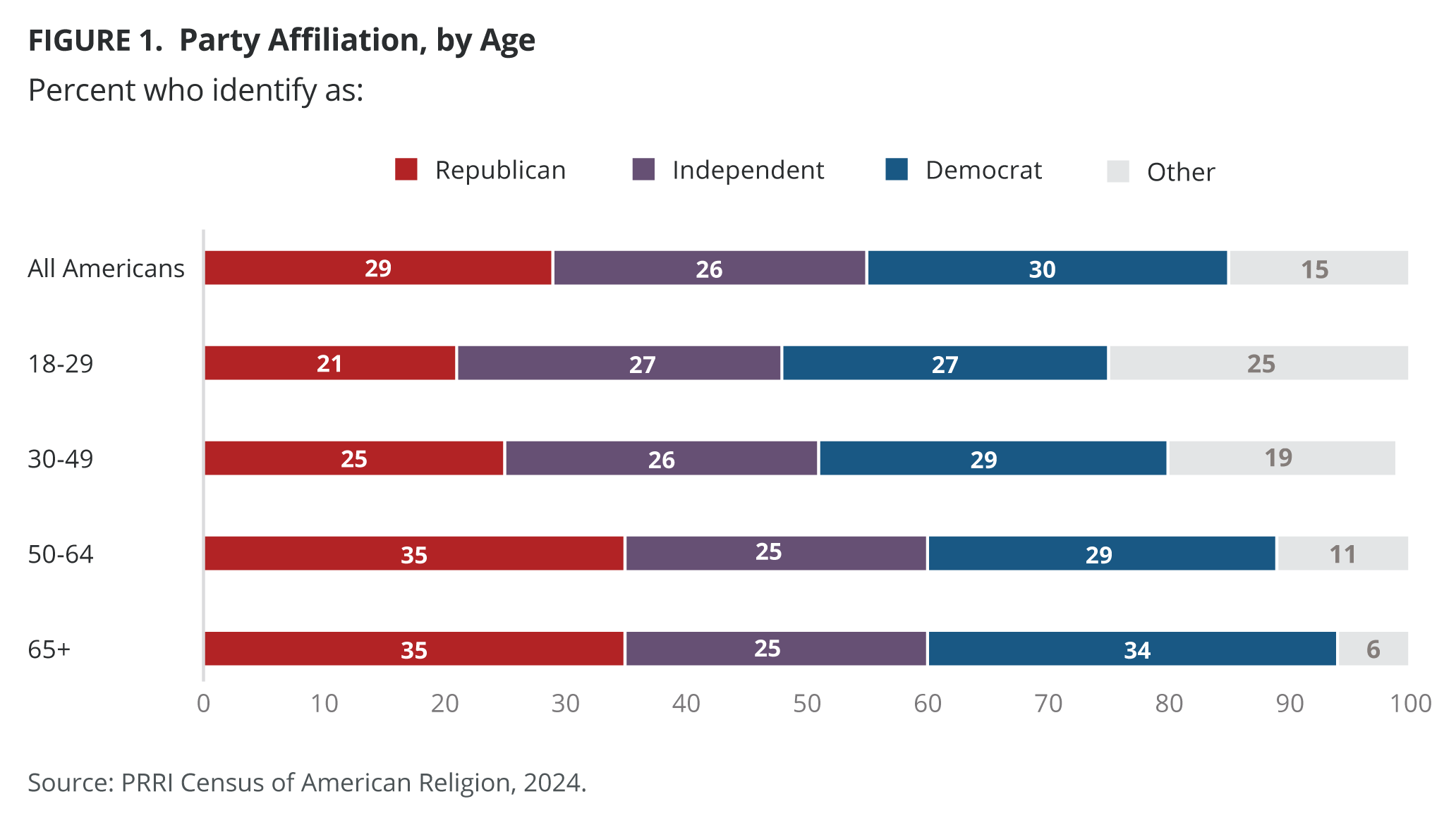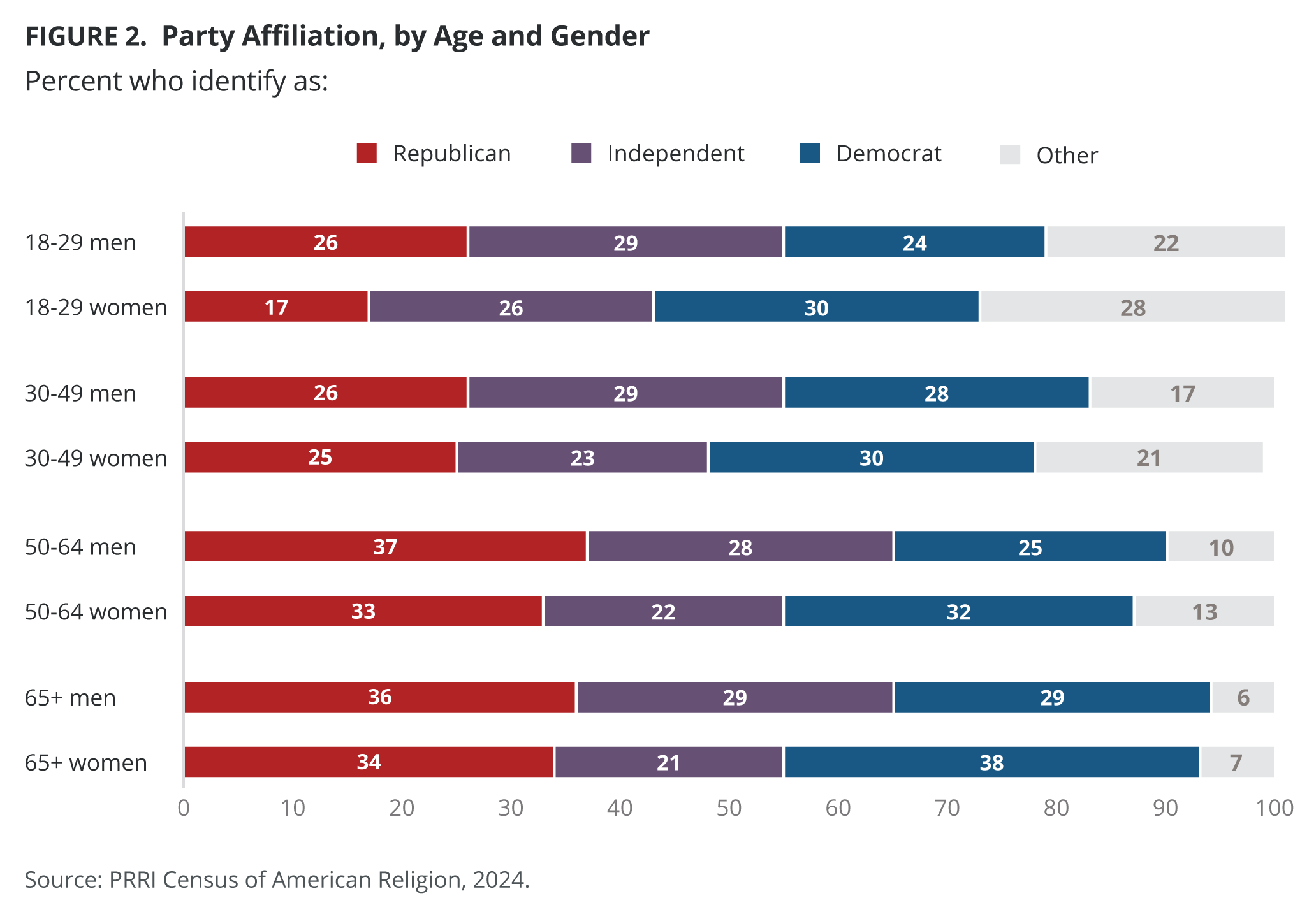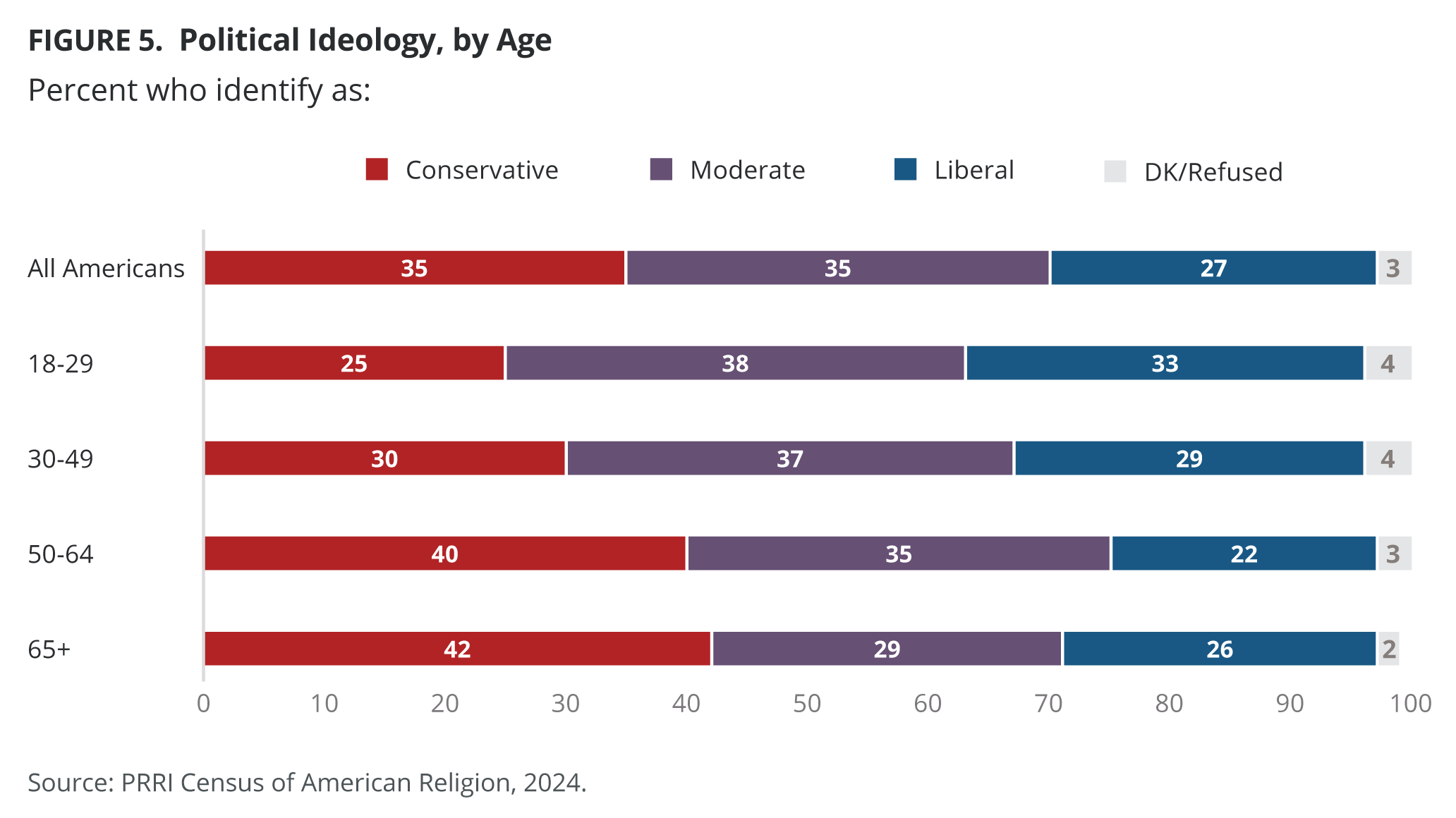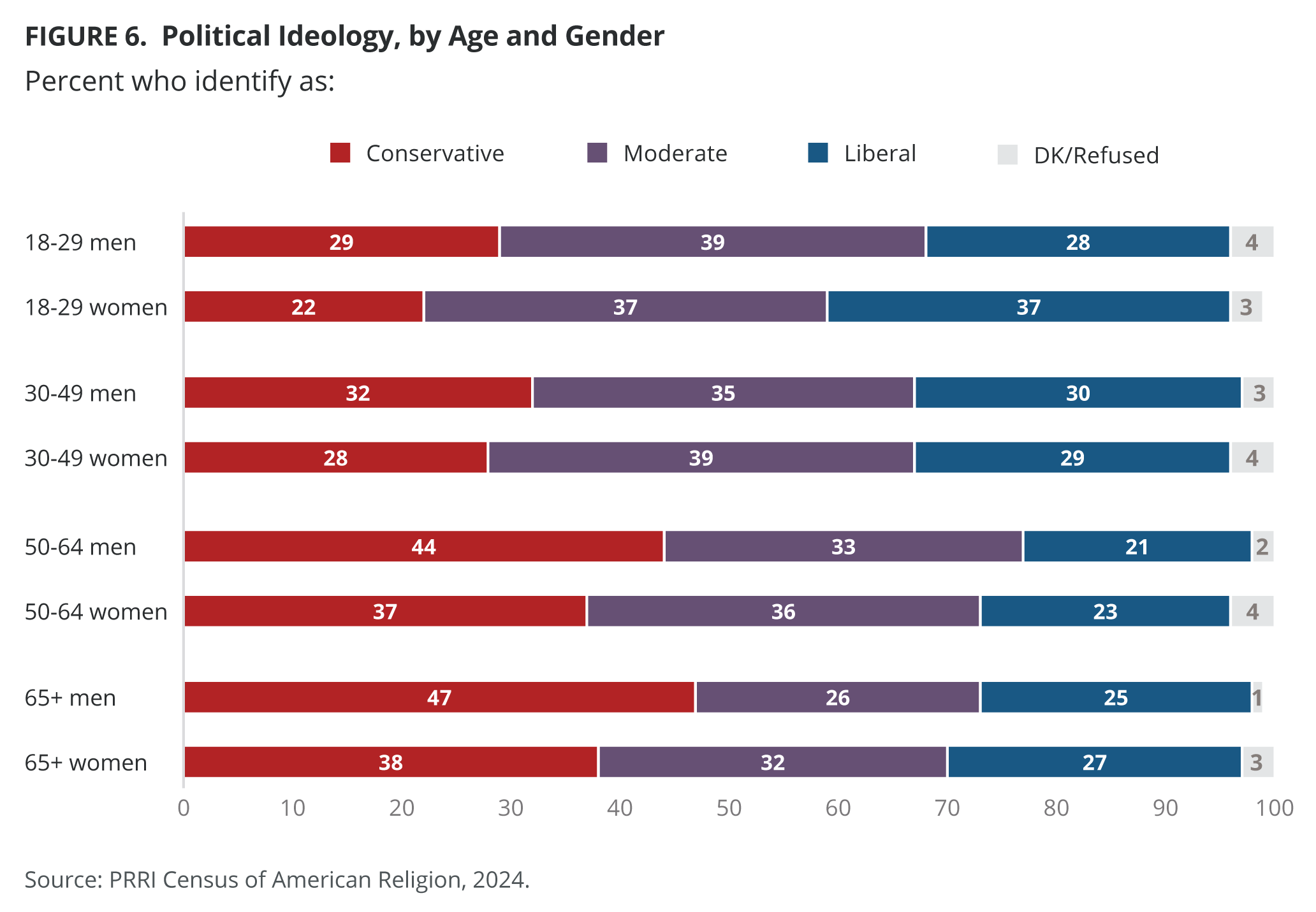Melissa Deckman, Ph.D., is the CEO of PRRI and a political scientist who studies the impact of gender, religion, and age on public opinion and political behavior.
As Gen Z Americans are growing into a larger proportion of the electoral voting bloc, a partisan and ideological gap is widening among young men and women. This Spotlight Analysis examines partisanship and ideology in the past decade among young Americans, considering changes by gender and race. While there have been some changes in partisanship among young Americans over time, their political ideology has remained fairly consistent over the past decade, with important caveats by racial groups.
Party Affiliation
The percentage of Americans who identify as Republicans has increased from 22% in 2013 to 29% in 2024, while the share of Democrats has fluctuated, rising from 32% in 2013 to a peak of 35% in 2020 before declining to 30% in 2024. Since 2013, the percentage of Americans who identify as political independents has dropped from 37% to 26% in 2024, while the percentage who identify as “other” has nearly doubled, from 9% in 2013 to 15% in 2024.
There is a clear connection between age and partisanship. In 2024, Americans ages 50-64 (35%) and 65 and older (35%) were more likely to identify as Republican than younger Americans ages 18-29 (21%) and ages 30-49 (25%). Three in ten Americans (30%) of all age groups identified as Democratic and around one-quarter (26%) identified as independent. At the same time, younger Americans ages 18-29 and 30-49 categorized themselves as “other” at notably higher rates than older Americans and Americans overall.

Compared with older Americans, the partisan gender gap among young Americans is the most pronounced. In 2024, 26% of young men identified as Republican, compared with 17% of young women — a 9-percentage-point spread. In contrast, the gap with respect to Republican identification was significantly smaller among other age cohorts. The gender gap in Republican identity among younger Americans has grown significantly since 2013, when 18% of young men and 14% of young women identified as Republican.

Since 2013, young men’s attachment to the GOP has grown, but most of this growth has occurred among young white men, whose affiliation with the GOP went from 26% in 2013 to 36% today. Notably, since 2021, we have seen an 8-percentage-point increase in Republican identity among young white men. By contrast, gains in Republican identification have been more muted among young men of color, though young Hispanic men saw a 6-percentage-point increase in Republican identification since 2021. Compared with 2013, however, young Black men’s Republican party identification has changed relatively little, with a brief uptick in 2019.
Young women have consistently been less likely to identify as Republican and more likely to identify as Democratic than their male counterparts across racial groups. In 2024, around one in four young white women aligned with the Democratic party (26%), compared with 18% of young white men. The gender gap in Republican identity among young Hispanic women ranges over time about 2 to 5 percentage points, but GOP identity has been very low among young Hispanic Americans, regardless of gender. In 2024, pluralities of young Black men (38%) and women (37%) identified as Democratic.
Notably, young Black women have experienced the most significant decline with respect to Democratic party affiliation, dropping from 62% in 2013 to 37% in 2024. Young Black women have not moved toward the GOP; however, we find that just 2% of young Black women identified as Republican in 2024 — a percentage that has largely remained static since 2013, with peaks of 7% in 2019 and 2021. Instead, young Black women have become increasingly likely to identify as independent, select “other” as a partisan category, or remain undecided about their partisan identity.
Political Ideology
In 2024, more than one-third of Americans identified as moderate (35%) or conservative (35%), while 27% identified as liberal. While the share of conservatives and liberals within the American public has remained consistent since 2013, the proportion of moderates has grown from 28% in 2013 to 35% in 2024, and the share of those selecting “other” to describe their political ideology has declined steadily from 9% in 2013 to 3% in 2024.
Four in ten older Americans identified as conservative, including 40% of those ages 50-64 and 42% of those 65 and older, compared with 25% of younger Americans ages 18-29 and 30% of those ages 30-49. In contrast, younger Americans are more likely than older Americans to identify as liberal. Roughly three in ten young Americans ages 18-29 (33%) and those ages 30-49 (29%) identified as liberal, compared with 22% of those ages 50-64 and 26% of those 65 and older.

There has long been a gender gap in ideology among Americans, and our data here show that for most age groups, women report being less conservative than men — except for Americans ages 30-49, whose ideological makeup is largely similar. Among young Americans in 2024, men ages 18-29 were more likely than women ages 18-29 to identify as conservative (29% vs. 22%, respectively) and less likely to identify as liberal (28% vs. 37%, respectively).

In 2024, young white men (38%) were more likely than Hispanic men (20%) and Black men (16%) to identify as conservative. However, there is no indication that young men have become more conservative in the past decade overall: 31% of young men identified as conservative in 2013, compared with 29% in 2024. Among white men, there has been some growth in conservative identity since 2019, from 32% to 38%, while young Hispanic and Black men have trended far less conservative over the past decade.
Compared with young men, young women have been consistently less likely to identify as conservative and more likely to identify as liberal. Ideological self-identification has remained largely similar for young white women over the past decade, while Hispanic young women have grown significantly less conservative, from 27% in 2013 to 17% in 2024. Conservative identification among young Black women has fallen in the past decade, from 25% in 2013 to 13% in 2024. Instead, young Black women have increasingly been more likely to self-identify as moderate, from 33% in 2013 to 48% in 2023 and slightly down to 43% in 2024.
While young men have long been more likely than young women to identify as Republican – and have become more so in recent years – they still do so at lower rates than American men overall, in part because relatively few young men of color identify as Republican and Generation Z is significantly more racially and ethnically diverse than older generations. At the same time, however, there is no indication that young men are trending more conservative in the past decade, although young white men have consistently been more likely to identify as conservative than either their Hispanic or Black counterparts.
Young women, by contrast, remain less likely than young men to identify as Republican or as conservative, yet they also demonstrate some partisan and ideological changes in the past decade. Compared with 2013, young white women’s Democratic partisanship has remained fairly stable, although there has been a slight increase in Republican identity. Republican identity among young Latinas and young Black women has remained very low in the past decade. Most notably, young Black women, who in the past strongly identified with the Democratic Party, are increasingly opting out of partisan labels, instead gravitating toward describing themselves as independent or, increasingly, selecting the “other” or “don’t know” option.





